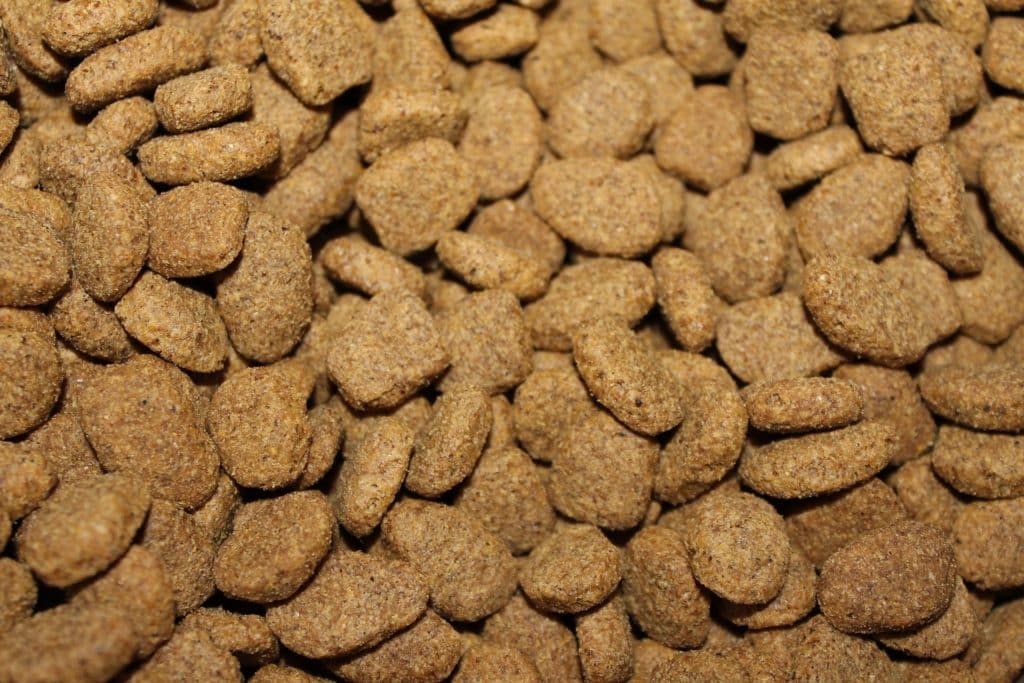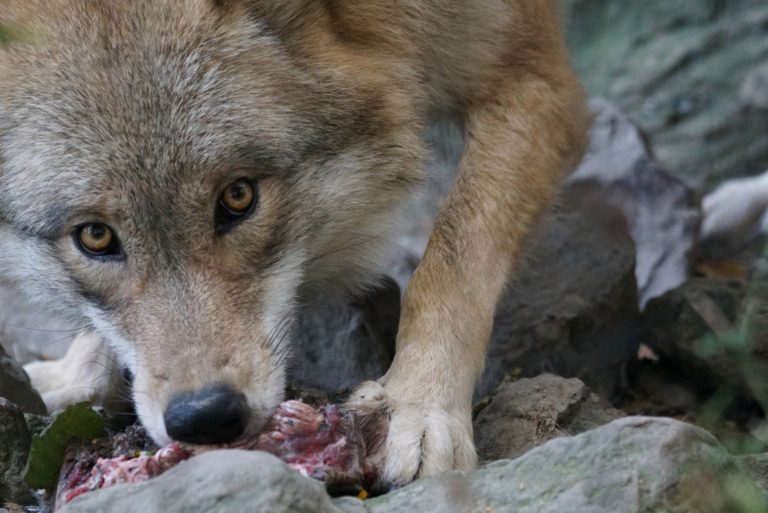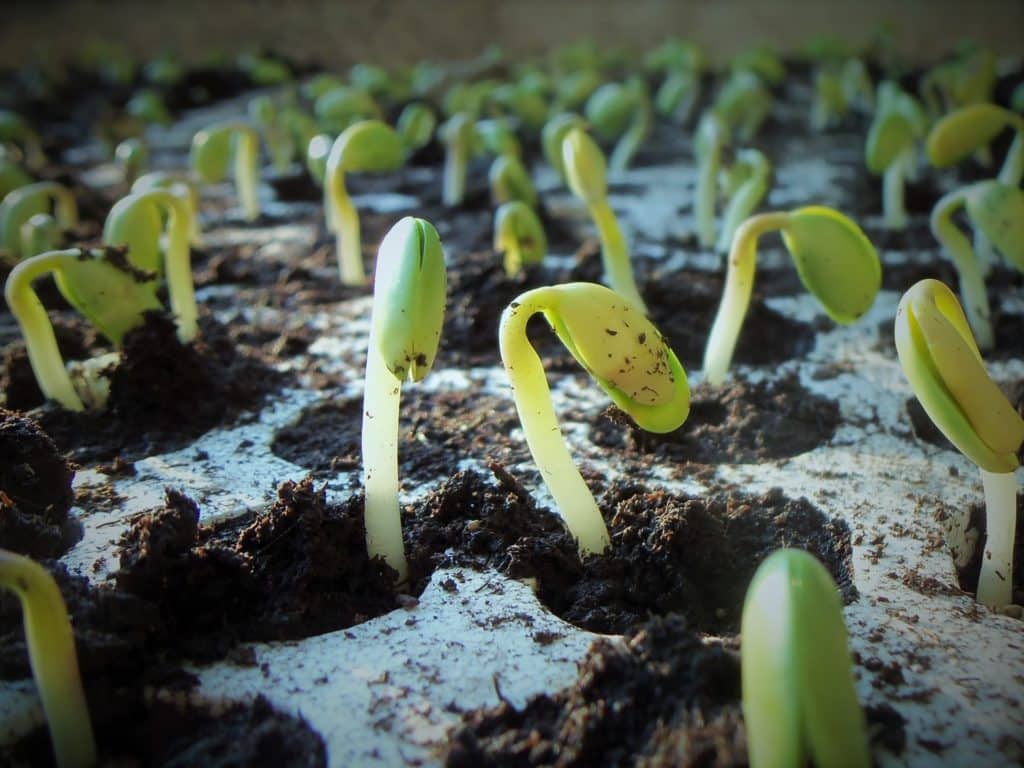Is Dry Food Harmful for Dogs? (9 Problems)
- Enrico Bachmann
- Updated: 2024-02-22
Like humans, dogs are increasingly suffering from lifestyle diseases. Problems such as obesity, diabetes mellitus, fatty liver disease, high blood pressure and osteoarthritis reduce your dog's quality of life and life expectancy. But why are these diseases on the rise?

Unlike today's sofa dog, the wolf's ancestor was a healthy, wiry hunter. Today, unfortunately, our dogs are often fed industrial food instead of species-appropriate food. But how harmful is it to feed your dog only dry food? I'll tell you in this article.
The Change of Dog Food in the Course of Domestication

The wolf hunts its prey in a pack. Social cooperation with other pack members allows them to hunt large prey.
In the Stone Age, there were many different types of wolves. They were not shy because they were not yet persecuted by humans. Hunting together brought benefits to both groups. The prey could be better defended against competing groups. The pups were raised in the protection of the cave.
Over time, the wolf adapted more and more to the social structures of humans. The former hunting partner became a working partner and finally man's best friend.
In the Middle Ages, expensive meat was reserved for the upper classes. Hunting and working dogs were fed grain porridge, bones, and meat soup. In times of food shortage, meat was usually in short supply. Dogs had to make do with cheap grain.
Shortly thereafter, feed manufacturers discovered the cheap raw material. Grain meal in particular was used to produce animal feed. In order to make the feed simple and attractive to the pet owner, the raw materials were subjected to various manufacturing processes. Dried feed was invented.
Is the Dog an Omnivore?
The canine dentition consists of 42 teeth. The six incisors in the upper and lower jaws are small and flat. They are mainly used to scrape meat off bones.
The much longer canines grip and hold the prey. There is a gap between the canines and the first molars. This makes it easier to grip prey firmly.
The rear molars have wide chewing surfaces. They can easily break up larger pieces of meat, cartilage and bone. With the strong scissor bite, pieces of flesh can be torn from prey with ease. There are no teeth for crushing plant parts.
The digestive system consists of a large stomach. The stomach acid breaks down proteins and bone fragments. Unlike herbivores, the downstream segments of the intestine, where starch is broken down, are short.
Protein-rich prey is quickly digested. Energy is rapidly delivered to the cells and stored. If there is no food for a few days, the energy stores are mobilized. The dog still has the energy to hunt for prey.
Although the dog has developed enzymes to digest plant matter during its domestication and can be classified as an omnivore, its dentition and physiology clearly indicate that it is more of a carnivore.
Why Was Dry Food Developed in the First Place?
Food was hard to come by in the interwar and postwar years. Fresh meat in particular was unaffordable for many people.
So the dogs were fed cheap grains and vegetables. Special manufacturing processes were developed to make the food last longer. Moisture was removed from the food.
The resulting pieces were dry and had a long shelf life. Feeding the dog became easier. Dog food could be easily taken on long trips. Dog owners' preference for dry food grew steadily. The pet food industry had a large, profitable market to serve.
How It Is Made
The term "fresh meat" is not really accurate. It is a dry mass from which almost all moisture has been removed.
In industrial production, the raw materials are heated to high temperatures, losing much of the natural nutrients. These are then added. In most cases, these are synthetic substances.
The addition of preservatives significantly extends the shelf life. The added sugar is disguised as grape sweetener, apple extract or caramel.
Why Do So Many Dog Owners Prefer Dry Food?
- The food has a long shelf life and can be stored without any major problems.
- Feeding is easy and convenient.
- There is no strong odor coming from the bowl, which can be unpleasant for sensitive dog owners, especially in warm weather.
- The amount of excrement deposited is significantly reduced.
- Cleaning the feeder is much easier.
What Are the Ingredients in Dry Food?

There are many different types of dry food on the market. Most are 60 to 80 percent carbohydrates. Animal protein is present in small amounts.
A vegetable protein source, soy, is usually used. This inferior source of protein can hardly be utilized by the dog's body. Due to the industrial drying process, the dog food contains very little moisture. Most cheap ingredients are difficult for dogs to digest and do not provide enough energy.
Even dry food without grains is not healthy. Large amounts of potatoes, sweet potatoes or rice are not necessarily part of a dog's natural diet.
Important vitamins, minerals and trace elements are replaced by synthetic additives. Various types of sugar are also often added to make the color of the food chunks more attractive.
Often, the dried feed does not even contain high quality grains. Often, hulls, shells and husks are used, which are waste products from flour production.
Is Dry Food Appropriate for the Species at All?
Dry food is sufficient for your dog's survival. It is species-appropriate. It will not lead to the extinction of the dog species. But is it appropriate? Is this type of food healthy for your dog and does it meet his natural needs? Clearly not.
The senses of smell and taste are also involved in the digestion of food. Dry food does not smell because the ingredients are no longer in dissolved form.
This causes the dog to produce too little saliva when eating. The dry chunks often enter the stomach unchewed. The only way to meet energy needs is to add various sugars.
9 Problems With Dry Food (What You Need to Know)
Dogs are gulpers. The small croquettes of dry food are not chewed, but swallowed directly.
1. Dry Food Damages Your Dog’s Teeth
Because the teeth are not adequately rinsed with saliva, food remains in the spaces between the teeth. The sugars in the dry food serve as food for the bacteria in the oral cavity. More plaque forms. Regular feeding of dry food leads to the formation of hard, brown tartar.
2. Dry Food Irritates the Stomach Lining.
The hard, dry crumbs can irritate the digestive tract of dogs with sensitive stomach lining. The problem is exacerbated by the increased production of stomach acid. The dog begins to vomit. The dry pieces are difficult to digest because there is not enough moisture in the stomach to dissolve the nutrients.
3. Your Dog Produces More Gases in the Digestive Tract During Digestion
The high proportion of low quality carbohydrates leads to increased gas formation in the digestive tract. The gas accumulates in the stomach overnight. The risk of gastric torsion is very high.
4. Dry Food Promotes the Development of Allergies
The intestinal mucosa becomes more permeable due to the ingestion of low-quality ingredients. Your dog is more likely to suffer from gastrointestinal inflammation. Larger molecules from the diet pass through the intestinal barrier into the bloodstream.
The immune system reacts more strongly to these substances. At the same time, more immunoglobulin E is produced due to the presence of gluten. An initial food intolerance becomes a food allergy. Your dog suffers from recurrent bloating and chronic diarrhea.
5. Dry Food Changes the Composition of the Bacterial Flora in the Gut
The bacterial flora in the gut loses its biological balance. The individual food components can no longer be broken down properly. Your dog can no longer get enough energy from the food and is less efficient.
6. Dry Food Damages the Pancreas
Because of the increased intake of carbohydrates and sugars, individual cells cannot store energy properly. As the blood sugar level rises sharply after eating, more insulin is released. The cells become insulin resistant. This leads to diabetes mellitus.
7. Your Dog May Become Overweight Due to Dry Food
You are constantly giving your dog too much and too little energy. Weight gain. The joints become overused. Osteoarthritis (chronic joint degeneration) develops.
8. Dry Food Damages Liver, Heart and Blood Vessels
In addition, more fat accumulates in the liver. The liver cells can no longer adequately perform their detoxification function. Fat deposits build up on the walls of blood vessels. Blood pressure and risk of cardiovascular disease increase.
9. Dry Food Causes Kidney Damage
The low moisture content of dry food puts a strain on the dog's kidneys. Metabolites are not filtered out of the urine in sufficient quantities. They are deposited in internal organs, blood and lymph vessels.
The resulting free radicals cause chronic inflammation. The risk of tumor growth increases. If your dog does not consume enough fluids over a long period of time, he may become dehydrated on hot days. Kidneys are permanently damaged.
This leads to chronic kidney weakness (renal insufficiency). The water content of a prey animal is 70 - 80 percent. This amount of fluid cannot be replaced by drinking water.
The Advantages of Dry Food?
Dry food is only good for the dog owner, not the dog.
The food does not smell and can be stored in small spaces. It is inexpensive and has a long shelf life. Even at high temperatures, dry food in the bowl will not spoil.
Your dog will get full quickly because the dry kibble swells up in his stomach. Your dog will need smaller portions of food. He will have less stool. The stools do not smell bad. The industry can use cheap raw materials to produce inferior food and make a high profit margin.
The Disadvantages of Dry Food?
Dry food has almost only disadvantages for your dog.
Because of the lack of smell, many dogs become picky about what they eat. Your dog's health will be permanently damaged. Your dog will have less energy due to poor nutrient utilization.
Your dog suffers from lifestyle diseases. His quality of life is diminished. His life span is shortened. Dry food, due to its high grain content, often contains molds and mites. These cause food allergies and digestive problems. Itching, chronic skin irritation and ear infections are common.
Is Grain-Free Dry Food Better?
Dry food is dry food.
The problem of lack of moisture also exists with grain-free foods. Potatoes, sweet potatoes, corn or rice cannot replace high-quality animal protein.
Regular feeding of corn can also lead to psychological problems. Corn contains too little of the essential amino acid phenylalanine. As a result, the brain produces too little of the neurotransmitters dopamine and serotonin. Depression and behavioral problems are the result.
If the grain-free diet contains high levels of pea protein, fertility problems may result. The bitch will no longer come into heat regularly. Miscarriages are more common.
Is Dry Food Really Cheaper Than Natural, Pet-Friendly Food?
Buying food is cheaper than buying high quality, natural, fresh ingredients. However, more frequent illnesses mean additional visits to the vet. These and the necessary medications cost more money than high quality food.
Maybe Your Dog Only Wants Dry Food?
Dry foods often contain grains and sugar. This is really junk food. Once your dog is conditioned to the attractants in the food, he will crave it. To change your dog's eating habits, you can start by soaking the kibble in water. You can then gradually replace the dry food with healthy, quality food.
Does Your Dog Need Food Around the Clock?
Fresh food cannot be left unrefrigerated for long at high temperatures. But will your dog get hungry if food isn't always available? Even in the wild, prey is not always available. Your dog may well go without food for a few hours. As an alternative, use a refrigerated automatic feeder that dispenses small portions at set times.
Does Your Dog Really Need a Specialty Dry Food?
High-quality fresh food contains better ingredients and meets your dog's needs better than dry food. You can control the amount of energy your dog needs with different portion sizes. Dry food puts extra stress on your dog's body and often does not provide the help you want.
My Conclusion & Tip
Dry food is convenient, but it can be harmful to your dog's health. If you are looking for the best solution for your dog, try kibble or wet food. Dry food is not the best choice and can be harmful. Here you can find all tested Dog food brands.

I am a certified nutritionist for dogs and founder of Hundeo. My mission is to guide you in the jungle of information with simple and clear recommendations.


What is your opinion about dried chicken feet?
In general, dried chicken feet are suitable as a snack for dogs. They usually do not contain artificial additives or preservatives and can support a dog's dental health (plaque). They are rich in proteins and taste very good to many dogs. However, it should be noted that they are high in calories and therefore should be fed in moderation. Dogs with gastrointestinal tract problems may have difficulty fully digesting chicken feet. It is important to make sure that the chicken feet are from a trusted source, properly dried and stored to avoid germ contamination.